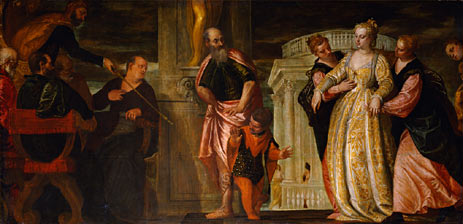 |
 |
 |
   |
 |
 |
 |
|
Paolo Veronese's Esther and Ahasver shows the scene from the Old Testament in which Esther pleads with King Ahasver for the life of her people (Esther 5:1–4). Esther, who lived with her Jewish family in the Persian capital of Susa, was chosen to become the favorite wife and queen of King Xerxes I (Ahasver). When Haman, the highest court official, plans to kill all Jews in the empire, Esther, who has never revealed her origin, decides to visit the king. This puts her in mortal danger, for whoever enters the inner court without permission is sentenced to death. Veronese, adhering closely to the biblical story, depicts the dramatic climax of the encounter: Dressed in her royal garment and accompanied by two maids, Esther arrives before the throne. In a gesture of forgiveness, the king points his scepter towards her. He and his train linger in the dark, while Esther is bathed in light, her regal air underscored by the temple in shining marble behind her.
The painting is part of a series of ten panels of equal size with scenes from the Old and New Testament: Lot and his Daughters leaving Sodom, Hagar in the Wilderness, Rebecca at the Well, Susanna and the Elders, Esther and Ahasver, Adoration of the Shepherds, Christ and the Centurion, Christ and the Adulteress, Christ and the Woman of Samaria, and Christ Washing the Feet of the Disciples. That the patron, the intended location, and the conceptual program of the series remain a mystery is quite unusual for a commission this size. It is possible that the paintings were originally conceived as a frieze. The composition is structured for a low—and distant—point of viewing and limited to a few figures set off against the dark background. There is little evidence to support the claim that the series was intended as a typological cycle. Only two pairs of images (Rebecca and Woman of Samaria; Susanna and Christ and the Adulteress) have a thematic connection. Most likely, the scenes function as examples in a more general sense.
The ten paintings are mentioned for the first time in 1613, as part of the estate of Charles of Croy, Duke of Aerschot, at Beaumont Castle in Hainaut, acquired in 1606 or shortly thereafter. The next owner was George Villiers, the first Duke of Buckingham. As a favorite of King James I, Villiers succeeded in making a rapid ascent at the English court until he was assassinated in 1628. Subsequently, his collection came into the possession of the duke's minor son. In 1648, it was shipped to Antwerp and offered to the new governor of the Spanish Netherlands, the Archduke Leopold Wilhelm. At the end of May 1650, Leopold Wilhelm bought the Veronese paintings with the bulk of the Buckingham Collection in the name and on the account of his brother, Emperor Ferdinand III, and had them transferred to Prague. Two of the paintings were brought to Vienna in the early eighteenth century, when the Imperial Galleries in the Stallburg were newly arranged. Six more—among them the work discussed here—followed in 1876. As late as 1962, the two remaining panels (Adoration of the Shepherds and Christ Washing the Feet of the Disciples) in the Royal Castle of Prague were identified as pieces of the Buckingham series and included in the newly established Prague Castle Gallery. Through an exchange in 1952, one of the Vienna paintings (Rebecca at the Well) was acquired by the Samuel H. Kress Collection and donated to the National Gallery of Art in Washington, D.C. Seven parts of the series are still on view in the Kunsthistorisches Museum in Vienna.
The uneven quality of the paintings, sometimes even within one canvas, has led to the assumption that Veronese's workshop had participated in their creation to varying degrees. Bernard Berenson and A. Ballarin see only the hand of the master at work. R. Pallucchini concedes a limited participation of the workshop, while J. Neumann sees it doing most of the work. For B. L. Brown, the series is a product of the workshop after Veronese's death, and T. Pignatti, who analyzes the contributors painting by painting, attributes Esther and Ahasver to Benedetto Caliari. The series, dated 1585 to 1588, is the fruit of the last phase of Veronese's creative life.
—Karl Schütz
|
|
|



